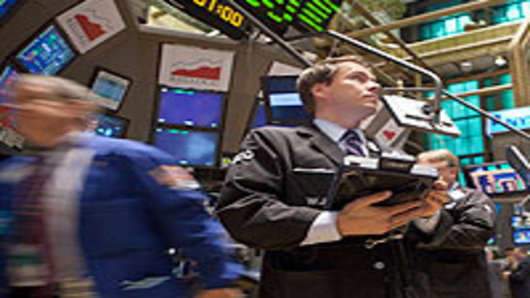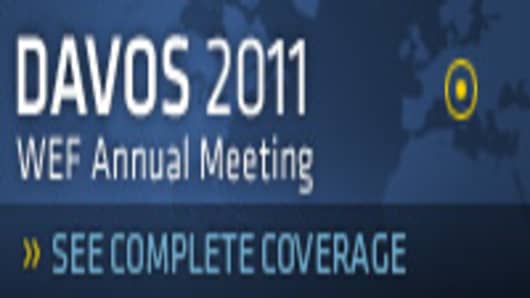The new normal is looking a little old hat.
The catchy and no doubt memorable phrase coined by Pimco boss Bill Gross amid the financial crisisis rapidly disappearing from Wall Street’s lexicon—and probably Davos' as well.
And that's probably a good thing.
With the Dow Industrials having almost doubled from its crisis low of 6500 and many economists calling for solid US GDP growth in 2011, the new normal—“half-size economic growth induced by deleveraging, re-regulation, and de-globalization"—has lost a lot of its usefulness.
The emerging consensus view is if USstockshave recovered can the economy be far behind?
“Can you really compare the two?" asks UBS Senior Equity Strategist David Lefkowitz. "There is definitely a correlation, but look at how margins in the corporate sector have risen so high, so quickly. If this was a more normal recovery, GDP would be growing faster than it is. That’s really the bottom line. [We’re in] a sub-par recovery.”
That may not qualify as a new normal.
Aspects of the labor market, however, are certainly something new.
“Look at long-term unemployment," says Lefkowitz. "The extent of the damage of the labor markets is as bad as we have seen since the depression. [And we’ve had] so much government support for such a long time, before we get to the point where the economy is standing on its own two legs, it’s too early to pass a verdict on whether or not we’re in a new normal.”
The level of the jobless rate is rare, but jobless recoveries—or slow labor market recoveries—certainly are not new, and in fact, may be more normal than not in the past 30 years.
What we’re accustomed to—what we think of as ‘normal’— is pre-crisis behavior; mainly because it represents the collective memory of the last decade as well as a good part of the 1990s.
During the easy-credit era, economic growth was enabled by the unsustainable leverage of the consumer. The leverage could be referred to as many things—unprecedented, outrageous, obscene—but certainly not normal. At the same time, Americans have been on a borrowing binge for three decades; it just intensified during the last one.
What we know for certain is that we’re in the post-steroid economic era, but that doesn’t answer the question: Where does GDP go from here?
The consensus estimate for full-year GDP growth in 2011 is about 3.5 percent, with more than a few forecasting 4 percent. Even stronger growth is expected in 2012. 4 percent for the final two quarters.
The economy may still be facing headwinds in housing and labor markets, but it also enjoying a substantial tailwind from both fiscal and monetary stimulus.
Tobias Levkovich, chief US equity strategist for Citigroup, argues that both consumption and corporate investment will eclipse the government’s spending hole and will allow for sustainable growth.
“Corporate confidence is coming back. We should get more durable [growth] now, given that credit conditions are improving," says Levkovich. "If you are waiting for bank lending to improve, you’ve waited way too long. Look at the Federal Reserve Board’s bank lending standards for commercial loans. Improved credit conditions lead business activity; hiring trends by 9 months, loan activity by 18 months.”
On the heels of JPMorgan Chase's Q4 earnings report, announcing an unexpected increase in loans, it looks like banks are in fact beginning to loosen their purse strings.
FAO Economics Chief Economist Robert Brusca is among those predicting 4-percent GDP growth this year, because of strong investor demand and the prospect of consumption going up.
Brusca doesn’t think turning off the faucet of government spending is such a formidable threat.
“We’ll pass the baton from government sector to private sector, If we get job growth. This is the image: Pushing a car up a slippery slope. I can see either side being right [government spending vs. consumption], but not both at the same time. If you keep pushing to the right spot, we’ll be in a place where the economy can sustain itself.”
“There is a much higher correlation between stock market growth and retail sales activity than there is between stock market and housing activity," adds Levkovich of Citigroup.
So the stock market is both a feel good factor and leading economic indicator.
There's nothing new about either of those things. The stock market rally peaked in late 2007, a year before the collapse of Lehman Bros. and the financial panicthat knocked over other giant financial firms like so many dominoes.
Of course, given the lightspeed offinancial marketsthese days, nothing is new for very long. That my be the lasting new normal.
"People come up with catchy phrases. I don't think its useful," says Brusca. "Pimco has been a believer in it. But they also forecast the recession long before we had it. They forecast the double-dip, it hasn’t happened. But they’re the gorilla in the room. You can’t ignore them.”



